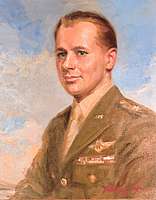Inducted in 1989
Developer Of All-Blind Flight Control System
1895 – 1983
Major General Albert Francis Hegenberger’s pioneering work in instrument flying and navigational systems led to modern aviation equipment, enabling planes to fly anywhere in almost all weather conditions.
Hegenberger graduated from the Massachusetts Institute of Technology as an aeronautical engineer and served as a flight instructor during World War I. Later, as Chief of the Instrument Branch, Air Service Engineering Division, at McCook Field in Dayton, Ohio, he began researching flight and navigation instrument development.
In 1927, Lieutenants Hegenberger and Lester Maitland were the first to fly 2,400 miles from California to Hawaii, the longest open sea flight to date, in the “Bird of Paradise,” a Fokker C-2 Tri-Motor. They received the Mackey Trophy and the Distinguished Flying Cross from President Coolidge for this achievement.
Captain Hegenberger went on to develop a blind instrument landing system. In 1932 he made the world’s first solo instrument-only flight at Wright Field, Dayton, Ohio. His system was adopted for both military and civilian use and became standard equipment in all larger airplanes and at all airports. This achievement earned him a second Distinguished Flying Cross and the Collier Trophy in 1934.

